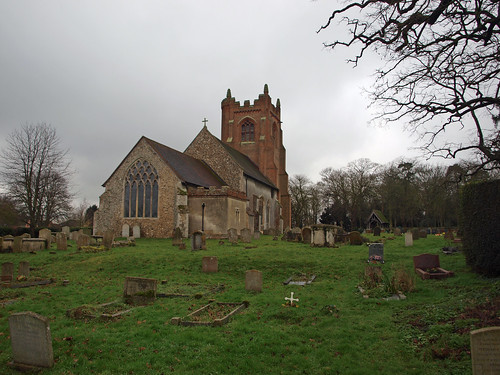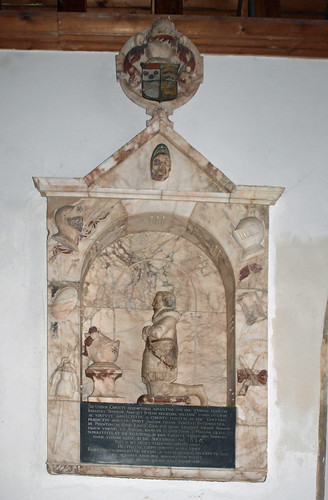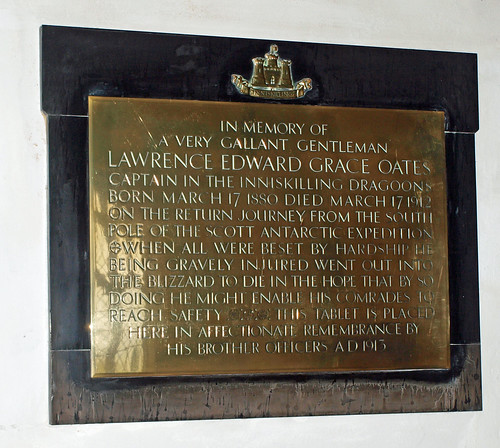St Mary is rather spartan and over-restored for my taste and was the most disappointing visit on this trip - perhaps my expectations were too high!
ST MARY. The church is small in comparison with the tower. This was added about 1498 (when 40s. was bequeathed by William Carter to the building of the tower) to a church partly Norman, partly C14 and partly C15. The chancel has a blocked C13 N window; the other windows are early C14. The five-light E window is specially interesting. The tracery is of a rare (early) variety of reticulation, where the net pattern is arrived at by simply placing arches on top of the apexes of other arches. The Sedilia inside the chancel have simple ogee arches. The S arcade of the nave was rebuilt in the C19. The W tower is of brick with blue brick diapering. It has angle buttresses, stepped battlements and short pinnacles.The W doorway and the W window are also of brick. The bell-openings are of three lights with one transome and have depressed pointed heads with intersecting tracery. About the time when the tower was built, the nave received a roof uncommonly splendid for Essex. It is of the double-hammerbeam type of which there are only a few examples in the county. - FONT. Octagonal, Perp, with traceried stem and a bowl decorated by shields and the symbols of the four Evangelists. - SCREEN. With one-light divisions. The heads are quite richly decorated; crocketed ogee arches and panel tracery above them. - STAINED GLASS. Seated Virgin in a N window, much restored. - MONUMENT. John Sparrow d. 1626, alabaster, with small kneeling figure.
Arthur was more fulsome but mostly due to it being the home of Lawrence Oates.
GESTINGTHORPE. Here lived a very gallant gentleman, though who could have imagined, seeing him as a little delicate boy walking in this pleasant wooded country, that he would live for ever as the matchless hero of Antarctica?
Three English explorers have passed mysteriously from the sight of men in our time: Irvine and Mallory were seen mounting up Everest and were lost in the clouds, Captain Oates walked out into the blizzard to give a better chance of life to Scott and his comrades. He was born in London while his mother was on holiday there, but this was the home of his boyhood, and the little 14th century church of flint and red bricks, with a few Roman tiles in its walls, has a brass plate in the nave which says:
In memory of a very gallant gentleman. Died March 17, 1912, on the return journey from the South Pole of the Scott Antarctic Expedition.
When all were beset by hardship he, being gravely injured, went out into the blizzard to die in the hope that by so doing he might enable his comrades to reach safety.
Every week, we were told, an old lady, her years running close to the nineties, walked to the church to polish this brass in memory of her son. Well she remembered the time when he was so delicate that he was sent to South Africa for three winters. He knew this place well as a boy and his home is by the church, the 17th century house called Over Hall, which we see through the lime trees. It was faced with brick and partly made new in the 18th century, and has a dovecot 300 years old with a pyramid roof, four gables, and nesting holes for 500 birds. There is another dovecot at Moat Farm a mile away, a medieval house with its original doorway. The countryside of Captain Oates’s boyhood is dotted with timbered and plastered farm houses—Park Farm with two original doorways and a 16th century chimney stack; Parkgate Farm, with the original roof of the hall; Edye’s Farm, with its old doorway and the roof of the old hall still in its upper storey.
They are peeps of old England to stir the imagination of any boy, and we do not doubt that Captain Oates would often think of them in those last bitter days of his life. Like the farmhouses, the church has doors which have been swinging on their hinges for centuries, its west door and the door of the tower turret being both 400 years old. The magnificent hammerbeam roof of the nave has been as we see it for 500 years; so has the roof of the south aisle. The beams and wall-plates of the nave roof are carved with foliage and the names of Peter Barnard, Marget his wyf ; and Thomas Loveday and Alys his wyf. Their children may have been christened at the medieval font, carved with an eagle, a bull, and a lion, all with wings.
From these medieval days comes a little glass in a window in the nave, showing a small crowned Madonna with her little Son on her knee, and the two richly traceried old bays worked into the oak chancel screen. There is an extraordinarily long dug-out chest with five locks, old paintings of Moses and Aaron, and a 17th century tomb on which John Sparrow kneels at a table in the armour of Charles Stuart’s day. He wears a ruff and baggy breeches, and all about him are the weapons of war of his time, pikes and spears and muskets, helmets and a suit of armour, a red standard, and a drum.
Here Died a Very Gallant Gentleman
ALL the life of Lawrence Edward Oates would seem to have been a preparation for those hours in the Antarctic when he walked to his death in a blizzard to try to save his companions beset by hardship. Never was a greater example of the truth that no man can tell till the end of his life what has been the most important hour in it.
He was only 32 when he died, and up till the years of his Antarctic Expedition his chief expedition had been in the South African War, where he just missed the Victoria Cross. He was with the Inniskilling Dragoons in India when he wrote to Scott begging to be taken as one of his party on the Terra Nova. He was asked to come to London to talk it over, and, the two men recognising in one another a kindred spirit, the sailor took the soldier, who was to have charge of the ponies. Oates, rather shyly, asked Scott whether he would have a chance of going on the actual sledge party to the Pole. The Commander replied briefly that he intended to take the four fittest men, and if Oates proved to be one of these he would certainly go on with him. With this conditional promise Oates joyfully embarked. The record of the 900-mile sledge journey to the Pole is best told in the diaries of Captain Scott, found near the dead bodies of himself and his last companions. The most heartrending sentence in it is in the message Scott penned to England:
Had we lived I should have had a tale to tell of the hardihood, endurance, and courage of my companions which would have stirred the heart of every Englishman.
That hardihood and courage belonged to Lawrence Oates in full measure. He added to them an act of sacrifice which raised this simple soldier to a height at which he shines as an inspiration to the world.
Almost from the beginning the sledge journey to the Pole was dogged with mishap. The preparations were long and difficult after the party had reached their starting base. One of the questions hard to decide was whether to take ponies or dogs or both, and the decision to take ponies involved a delay of some weeks, because they could not stand the winter climate. The delay also caused another entirely unexpected misfortune, the character of which was only learned when it was too late. All unknown to Scott, while he delayed, Amundsen with his Antarctic party was starting on the same journey by a shorter route, and with more fitting equipment. Fortune favoured the Norwegian, and seemed to set its face against the English party from the first. They were behind their scheduled time and dared not pause for rest lest their food rations should not last. There was nothing but to go trudging on, hauling their sledges with agonising effort.
In spite of the heavy going over soft snow or crumbling ice they contrived to keep to nearly ten miles a day, but it was at terrible cost to themselves, and each began to ask himself how long he could keep the pace, and each to fear that his weakness might betray the others. What their nights were when they shivered, half-frozen and half-thawed, through brief hours of exhaustion, and when they seemed neither asleep nor awake, we hardly find it possible to think.
At last, when the lessening stock of food had lightened the sledges, they had only 27 miles to go; another two good marches would l take them to their goal. On January 16 they had been marching about two hours when the seaman’s eyes of Lieutenant Bowers saw something like a cairn of stones. But how could it be a cairn? Were they not the first to cross this untracked solitude? They marched on. Another half hour and there was a black speck far ahead. The bitter truth burst on them. With sinking hearts they came to a black flag tied to part of a sledge, and, drawing nearer, saw sledge tracks, marks of skis, and the footprints of many dogs pointing to and from the Pole. Amundsen had beaten them; the intrepid Norwegian had come and gone.
0ur own hearts sink as we try to realise the bitter shock of disappointment to these worn and bewildered men. Had they indeed been the first to set their feet at the South Pole the exultation might have so raised their spirits that they would have set out on the return journey with bounding pulses and renewed vigour. It was not to be. They must face the miles back with the bitter consciousness that, though they had done their duty, it was not enough.
It was on the merciless journey back that Captain Oates broke down in body though his spirit triumphed to the end. His feet had been frost-bitten; he could scarcely stumble along; his iron will could not keep him in the traces of the sledge. He was left to sit on it while the others searched for tracks, and then to plod behind alone with his thoughts. He asked his nearest friend among them what he should do, and all the friend could say was "Slog on—just slog on," though both knew death was certain.
So Oates tried to battle to the end, though doubts came with every dawn and lasted through every agonising day. His hands were useless; his feet would barely support him. Try as he would he kept the party waiting. He came to the end of his endurance. He could not go on. He asked them to leave him behind in his sleeping-bag. But they would not leave him, though they knew his hours were numbered, and he struggled on a few miles more, when they camped. He awoke in the morning after a little sleep, and as he woke he knew what he must do. He struggled to his feet and limped out into the blizzard. He bade no goodbye; he said only: I am just going outside; I may be some time.
He was going out so that his companions should not be burdened with his company. The chance was faint, but his going might give them some hope of life denied to him.
Long afterwards, when the bodies of the others were found, a service was read over them beginning with the words: "The Lord gave and the Lord hath taken away; blessed be the name of the Lord." Over the body of Oates no service could be read, for the snow of the blizzard had enfolded it forever; but near the camp where he went forth into the swirling snowstorm a rude cross has been set up, and on it are the words: Hereabouts died a very gallant gentleman.
Simon K -
Pleasantly situated church between Sudbury and Castle Hedingham, with a handsome red brick tower. It is best known as the home parish of the Oates family, explorers extraordinaire, the most famous of whom was Captain Oates who was immortalised as a great English hero after walking into a snow storm to help ensure the survival of the rest of Captain Scott's Antarctic expedition. He is commemorated inside the church.
Simon K -
Pleasantly situated church between Sudbury and Castle Hedingham, with a handsome red brick tower. It is best known as the home parish of the Oates family, explorers extraordinaire, the most famous of whom was Captain Oates who was immortalised as a great English hero after walking into a snow storm to help ensure the survival of the rest of Captain Scott's Antarctic expedition. He is commemorated inside the church.



No comments:
Post a Comment